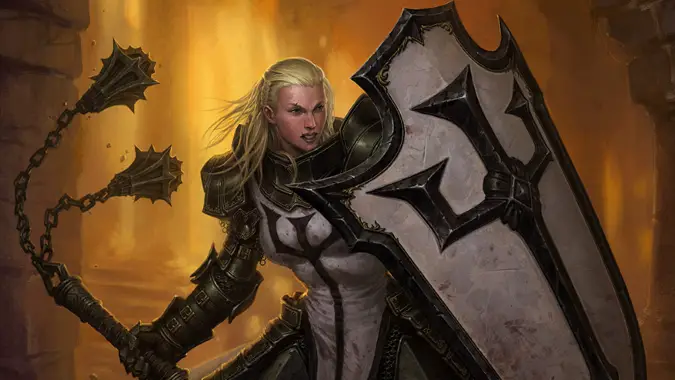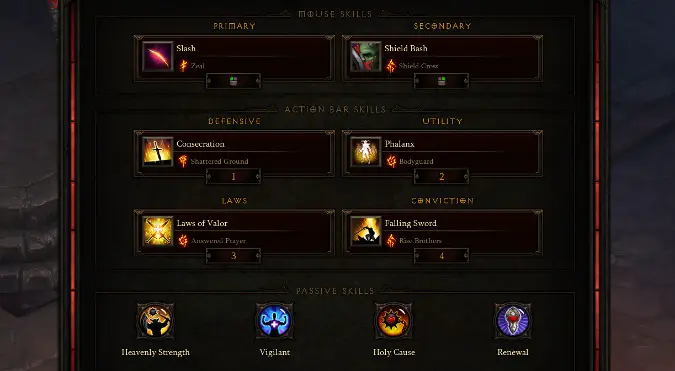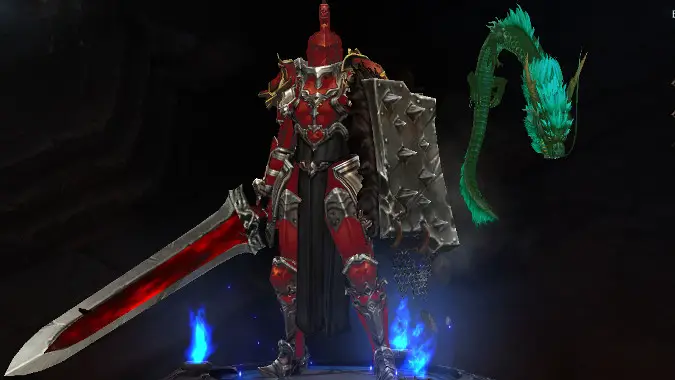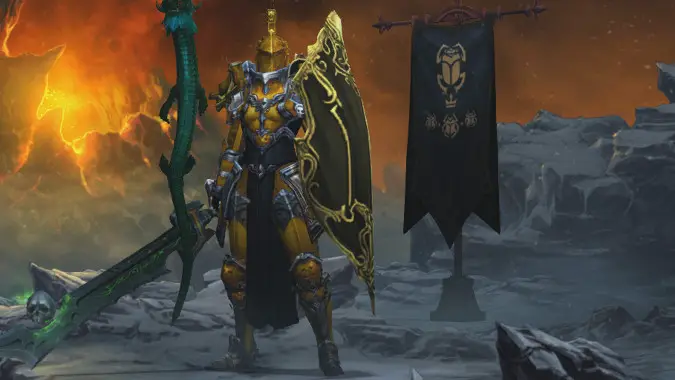The Diablo 3 Crusader for beginners

We’ve covered the basics for the Barbarian class in Diablo 3 already — but what if Barbarian doesn’t do it for you? What class would? Why not the Crusader class?
The Crusader is a bit tankier than Barbarians. It’s a class that can still deal out the melee damage but which also focuses more on surviving. It’s a class whose resource is similar but less spiky than Barbs. And it’s a class which has a very strong kit of abilities reminiscent of the Diablo 2 Paladin — but with a more martial, zealous flavor. If that sounds more your speed, then the Crusader might just be for you.
I have leveled a couple of Crusaders to 70 through Season play, and they’re an interesting mix of doling out punishment and absorbing a lot of it without going down. In some ways, they feel better suited to group play than the Barb. And if you’re a WoW player who always dug the Protection Warrior or Paladin playstyle but wanted to use a great honking two-handed weapon and a shield in your off-hand, I would definitely recommend giving Crusaders a shot.

To destroy the wicked
Crusaders start off like every other Diablo 3 character — practically naked, save for a white weapon and shield. By level 30, you’ll have access to every tier of primary, secondary, defensive, utility, and law abilities, plus all but one of the classes’ Convictions. You’ll also have three out of the four passive skill slots with slightly less than half of the passive skills available to choose from. By level 30, I’m usually rocking this build, which does a decent job balancing between unleashing pain on your enemies while staying upright through swarms of things.
The way Wrath works, you usually enter a fight with a full orb, so you can typically throw a big damage attack at whatever you’re fighting to start with. I love dropping a Falling Sword right off the get-go, but that’s only something you can start doing once you’re around the mid-20 level range. When you first start playing, you’ll have one active skill and nothing else, and you won’t get your first secondary Wrath spender until level 2 with Shield Bash.
Honestly, to my mind, the most important choice to make is at level 10 when your first passive unlocks and you can decide whether to get Heavenly Strength or not. Pretty much any other choice you make at these levels is fine — it all kills monsters, it all works. But Heavenly Strength changes the way you play your Crusader. Do you use a simple one-handed weapon and shield combination, or do you pick up an enormous two-hander and swing it around in one hand like your Wrath has made you a titan?

How to lay low the monstrous
I think we can already dispense with pretending I would ever even play a Crusader without taking Heavenly Strength. But I don’t think that means you should. If all you’ve been finding are one-handed weapons, Heavenly Strength is kind of useless, and you should take Fervor instead. I recommend taking passives that let you take more of a beating. For example, the following passives are solid choices:
- Vigilant, which increases health regeneration and reduces non-physical damage by 20%
- Renewal, which provides you with health every time you block
- Hold Your Ground, which dumps Dodge but boosts Block by 30%, and is great when paired with Renewal
- Divine Fortress, which increases your armor by your shield’s chance to Block.
As you play, you’ll learn how much healing and defense you actually need, and how much you can sacrifice for damage passives like Holy Cause and Fanaticism — the former boosting your weapon damage and healing you when you deal Holy-based abilities, and the latter increasing your attack speed whenever you use Smite, Slash, Punish and Justice.
Speaking of those four abilities, they are your Wrath-generating attacks. You get Punish at level 1, Slash at level 3, Smite at level 11, and Justice at level 15. They all generate 5 Wrath, so there’s no real clear cut optimum choice — it comes down to what you want to be able to do with your Wrath-gen attack. I almost always choose Slash because it works and I’m not terribly imaginative.
Crusaders are capable of a wide variety of tactics — you can build an aggressive Crusader who risks everything on flinging around as much damage as possible knowing it will heal them, or you can build a more tactical-minded one who goes for a “slow and steady” approach. It’s a class that rewards making choices that have good synergy. And unlike many classes in Diablo 3, the best Defensive abilities the Crusader gets either stun or disorient whole groups of enemies or buff all of your allies. In those cases, I recommend Shield Glare to AOE blind or Consecrate to heal your friends, respectively.

Tying it all together
So how should you play your Crusader? What tips can I give you to make it easier, whether you’re just picking up Diablo 3 for the first time some six years after it first came out or just giving the class a try in Season play?
- Commit to a playstyle. At levels 1 through 10, it really doesn’t matter what you do, but at level 10? Take either Heavenly Strength or Fervor and drive everything toward that decision. Decide if you want to be a slow-and-steady tank or a reaping destroyer, and make the proper passive choices to benefit that goal.
- Alternate between Primary and Secondary attacks. I found I had the best results when I would hit with a Secondary to open combat, then use a Primary, then a Secondary again. You start with a full Wrath orb, so make use of it.
- Don’t forget Laws and Convictions. Convictions are essentially just big attacks — I like to use them when I see a knot of demons or undead clustered up and in need of a whupping. But Laws are interesting abilities that have both a passive buff to you and your allies and an active on-use ability that acts like a cooldown for you and your group. Get comfortable with them and how to use them to help yourself and anyone you’re playing with.
- Remember, Crusaders are a solid group backbone. Laws are a good example of why a Crusader brings a lot to a group. In a game that doesn’t really have tanks, Crusaders might just be the closest thing to one — damage resistant, with strong group synergy thanks to their Law abilities, and a host of solid defensive options that can incapacitate whole groups of foes or heal and protect all of your allies at once. One of the strengths of the Crusader is it makes an excellent team player.
Crusaders are a fun class to play if you’re into being the shield that smashes in faces, the bulwark others break themselves against. There’s a lot more fun stuff to the class — you can boost your Thorns damage and make enemies regret they ever tried to hit you, or you can burst into white-hot light that sears them with every strike of your weapon. Overall, the Crusader offers a steadier, more deliberative playstyle than some other classes. It’s less the wild frenzy of the Barbarian or the disciplined mastery of the Monk and more a kind of pendulum swinging violently between extremes and crushing anything silly enough to try and stop it. And it can be a lot of fun.
Please consider supporting our Patreon!
Join the Discussion
Blizzard Watch is a safe space for all readers. By leaving comments on this site you agree to follow our commenting and community guidelines.
 @MatthewWRossi
@MatthewWRossi



